#WakingTheFeminists was a grassroots campaign calling for equality for women across the Irish theatre sector that ran from November 2015 to November 2016.
Now #WakingTheFeminists have donated a digital collection to the National Library of Ireland, as well as a physical collection (including the iconic banner pictured below) to the National Museum of Ireland.
We're delighted to publish Founder and Campaign Director Lian Bell's speech marking the occasion - watch above, and read below.
There's a strange feeling at marking a significant milestone in a collective, collaborative social campaign with each of us in our own rooms. Not to mention the irony of celebrating women in Irish theatre, at a moment when Irish theatre is essentially on pause. However, I feel like it is precisely because of this that the marking of this archive is important.

Theatre is the ultimate opportunity to feel and think collectively. Being together allows us to find our common ground. I recently attended a wonderful talk (online naturally) by Dr Aoife Monks called In Defence of Craft. She made the argument that one of the reasons costume workers (traditionally women) were often paid less than stage workers (traditionally men) was that the costume work was primarily done in the women’s own homes. The men had more opportunity to work together in the theatre building, to share their experiences and to begin collectively to argue their worth. That is of course only part of the picture; the long-running discrepancy in payment to costume workers is often credited to the fact that women’s work in general is undervalued.
Soon after #WakingTheFeminists began, I heard anecdotally that Dublin Theatre Festival had brought the daily costume rate for casual crew up to be equal to the daily technical rate. That is only one tiny example of the #WakingTheFeminists effect. You see, there is nothing more powerful than people gathering and talking with each other.

Marie Mullen outside The Abbey Theatre, November 2015 (Picture: Fiona Morgan)
I first made contact with the National Library in June 2017 about setting up a #WakingTheFeminists archive. The work on the archive over the subsequent three and a half years has been a labour of love, but a hugely important final step in our campaign. We knew from the get go how important it was to ensure that #WakingTheFeminists was properly archived. We saw first-hand how easy it is for women’s stories, women’s voices, and women’s achievements to be overlooked, and how quickly they fade.
We need your consent to load this rte-player contentWe use rte-player to manage extra content that can set cookies on your device and collect data about your activity. Please review their details and accept them to load the content.Manage Preferences
#WakingTheFeminists - Lian Bell and Sarah Durcan talk to Today with Sean O'Rourke in 2016
We want to thank Sandra Collins and all in the National Library of Ireland’s digital team, especially Della Keating and Ger Wilson for their patience and dedication in making this archive a reality. By agreeing to house the #WakingTheFeminists collection they are ensuring that a campaign that could only have happened in the era of social media and digital communication will not be forgotten.
Between this digital archive and the physical archive that is now housed in the National Museum of Ireland, #WakingTheFeminists has taken its rightful place in our national story. We stand in solidarity with all women who have been denied the right to be remembered. Whose stories are not told. This week, of all weeks, with the Mother and Baby Homes report being published, those women in particular and their children are in our minds.
Watch: One Thing More - #WakingTheFeminists at the Abbey Theatre in 2016
Today many of us who were key to the #WakingTheFeminists campaign are here to mark this official remembering of our story, peering at computer screens in our separate rooms. We’re also joined by some of the photographers who have generously included their work in the archive. I can’t wait to raise a glass in celebration with you all. This archive, we hope, will inspire future historians, theatre makers and feminists, and we hope it will give a small insight into the workings behind a whirlwind year that changed Irish theatre, and by extension, Irish society.
I have a short slideshow of images from the archive to play for you, with a soundtrack by the musician, composer and sound designer Alma Kelliher. I wanted to go with 60 seconds, but you try squeezing that incredible year into one minute.
Before I do that, I have a short text to read to you. It’s an extract of the most recent addition to the archive, being emailed to me only a few days ago. On the morning of the first #WakingTheFeminists gathering at the Abbey I was standing out the front of the building in a growing crowd of women, with press photographers amassing. I was told that a banner was on its way and that "Molly was cycling it over". I had no idea who Molly was, but I had faith.
Molly O’Cathain now works as a professional set and costume designer, but at the time was a student at the Samuel Beckett Centre in Trinity College. She writes:
I don't quite know why she thought of me really, but I ended up making the banner because Sarah Durcan called me one night. I didn't really know Sarah but have always liked her, and had a lot of respect for her. It was like a call to arms; a 'your country needs you’ moment. I remember asking her How Big should it be? Answer: "As big as you can manage!"
I think I hightailed it to Ikea to buy canvas, I went around to my mum's house late that night (she's a screen-printer and used to have a studio with a big table), called for back up (Liadain Kaminska and John Gunning soon joined me). We gaffer taped the letters (working from the middle I think, it was tricky as we could only ever see about 1/4 of it at a time on the table) and then rollered over it with black paint, the kind you use to paint theatre floors. (not sure where I grabbed that from, Players maybe?) We worked late into the night and then the next morning I got two broom handles, sewed pockets for them and delivered it into the Abbey.
Molly’s contribution gives a sense of the way things worked throughout the campaign. There was such goodwill, such absence of ego, and such a feeling that it was now or never. Someone was asked to help, jumped in with both feet, and used their skills to the maximum. The photographs with that banner, of course, became the iconic visual calling card for #WakingTheFeminists, used in the media across the world. And the rest, as they say, is well-documented, and soon to be very well-archived history.
Thank you.
Find out more about #WakingTheFeminists here.
